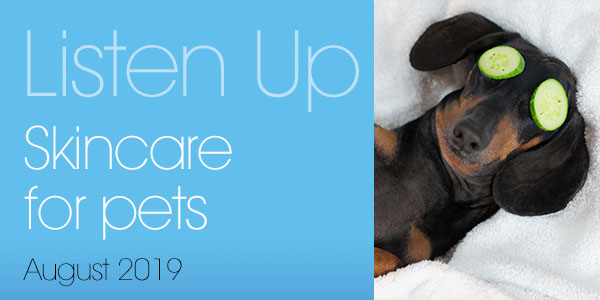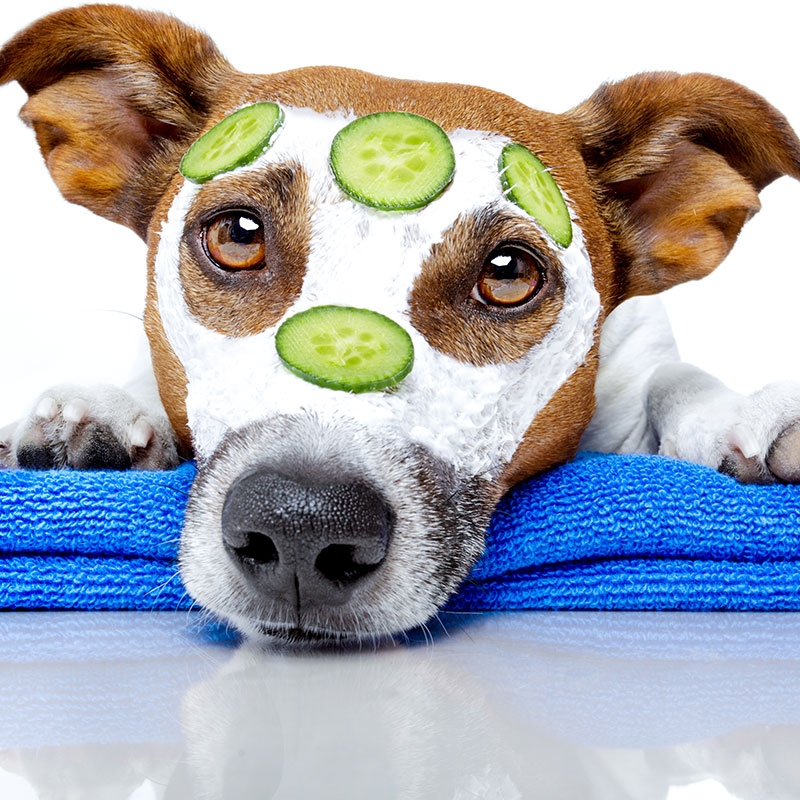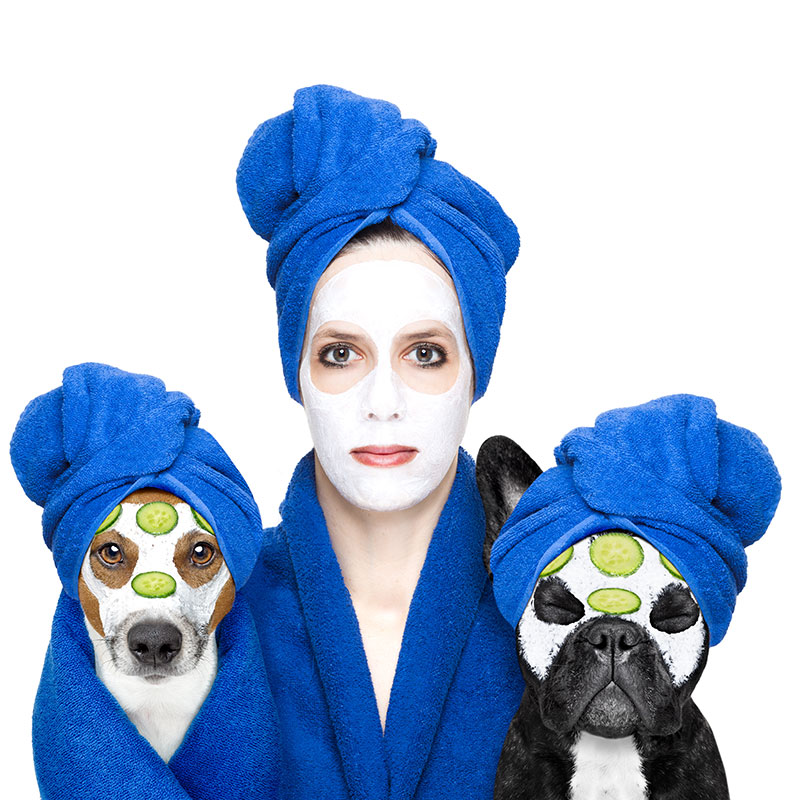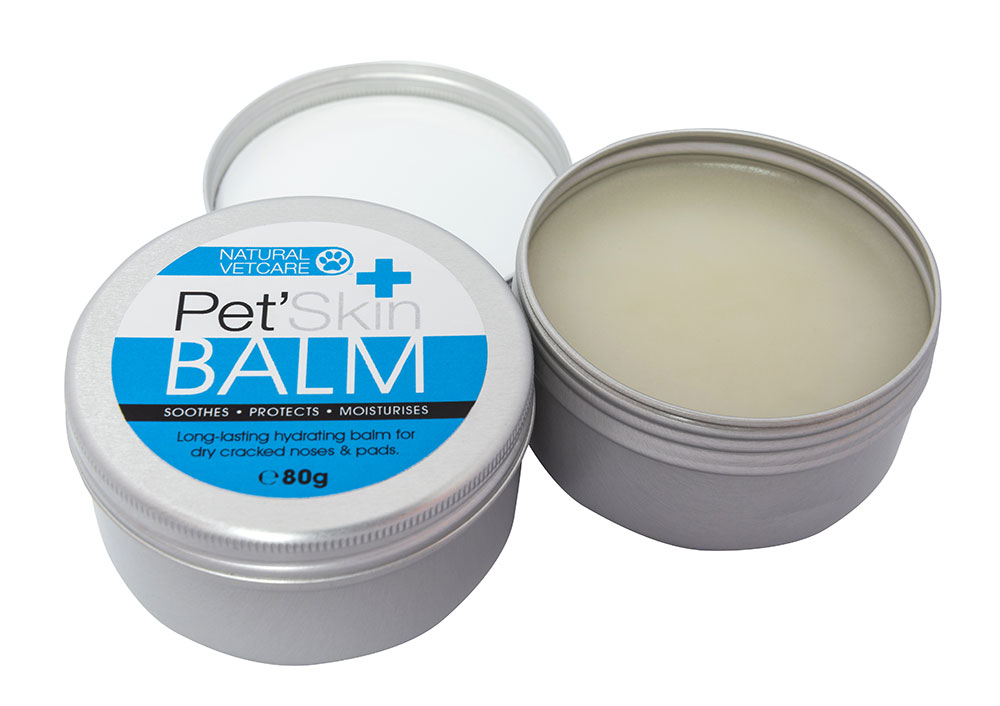


Skincare for pets: Because they’re worth it!

Every year, billions of pounds is spent in the UK on human skincare. When asked, many people will tell you they have a particular type of skin, perhaps yours is ‘sensitive’, ‘dry’ or combination’?
Entire aisles in shops are devoted to skincare products; from masks to moisturisers, washes to wipes. We clearly recognise as a nation, the importance of taking care of our skin, so why do we tend to think less about our pets’ skin health?
How much do we really understand about the products we use on our skin and how suitable are those products for using on our pets?
Today we are going to delve into the science behind some of those product claims and look at why it’s important to use the correct products on your pets’ skin.
What is the Skin Barrier?
The skin is made up of layers of skin cells (think of these like the bricks in a brick wall) held together by ceramides (fat molecules which act like a form of cement). In the same way that you can build a strong wall if you use good quality bricks and cement, the body can make a strong skin barrier if it uses healthy skin cells and the correct ceramides.
In addition to skin cells, your pet’s skin contains immune cells, blood vessels, hair follicles and many other structures that help to protect their insides from environmental threats such as harmful bacteria and allergens, at the same time as helping their body to retain important substances like water. Water loss through the skin barrier (sometimes referred to as trans epidermal water loss or TEWL) is an important marker of skin health. A poor skin barrier tends to become leaky and the skin loses moisture too easily, giving it a high TEWL value. Moisturisers therefore often form an important part of skincare management.
Many things can cause the skin barrier to weaken. Poor diet can result in weaker ‘bricks and cement’, trauma can damage the barrier and some bodies are simply unable to make a strong barrier even if they are given the correct materials, due to underlying health problems.
Sitting on the surface of the skin is a population of billions of microorganisms, often referred to as the skin’s microbiome. This ecosystem of bacteria, viruses and fungi help to defend the body and assist in keeping the skin healthy. The microbiome of a species and of individuals within a species can be entirely dissimilar to others. New research is taking place every day to understand this phenomenon more fully, but we already know that the microbes live in delicate balance with each other on the skin and can be disrupted by changes in skin pH or the introduction of new harmful microbes.

Human vs Pet Skin
The skin of humans, cats and dogs is very similar but it is not the same. Human skin tends to be much thicker than that of dogs or cats, it is also more acidic and has a slower rate of cell turnover.
All of which mean that it is often not appropriate to use a human skin product e.g. a shampoo on a dog or a cat. As vets we are well aware that many owners use human products on their pets and feel that these products have no negative impact on their animals.
However, we still tend to stress the importance of using animal products on animals because aside from potentially disrupting the delicately balanced microflora on your pet’s skin, human products can contain substances which are perfectly safe for humans but not at all safe for animals. So if in doubt, please ask a vet before using a human product on your pet.

Skincare For Pets
So, what should you be doing to keep your pets’ skin happy and healthy?
If your pet is fortunate and does not have skin problems, then they will likely require very little day to day skincare. If you are feeding them a complete, life stage and lifestyle appropriate diet with all the recommended ingredients to support their skin health (like Vitamins A, D and E, essential fatty acids and supportive minerals such as Biotin and Zinc) and if you are making sure they receive regular grooming (with the occasional bath when necessary) to remove excess dirt, dander and shed fur, then their skin and coat should stay in tiptop condition.
If, however, your pet is prone to skin issues then you may find you need to intervene. If their skin is dry, flaky, greasy or sensitive or if you find they are prone to becoming itchy or smelly, you should speak to your vet about possible causes and remedies. In addition to recommending foods and supplements to help your pet, it is common for vets to also recommend some form of topical therapy for skin health. Shampoos, balms, creams, sprays, gels, lotions, ointments, wipes... you name it, it’s out there!
A recent survey showed that pet owners were using a minimum of three different products to help manage their pets’ skin problems, which is exactly what vets want to hear! Particularly where a health problem cannot be cured (as with various skin diseases) it is beneficial to use a multimodal approach to managing it. What this means is using multiple different therapies together to achieve a greater overall positive result whilst reducing the negative impact of any single therapy.
In short, every little thing you do, can contribute both to an improvement in your pets’ skin health and a reduction in negative side effects. It’s a little more effort but it’s worth it.
But My Pet Doesn’t Like It
We understand that topical products like creams and sprays can be challenging to use if your pet doesn’t enjoy having them applied, but it pays to be patient to get your pet used to having them. If you’re finding it tricky...
- Speak to your vet about desensitising your pet to having their treatment.
- Make sure you reward your pet for letting you do the treatment with lots of cuddles and treats.
- Avoid strongly scented products which can irritate your pet’s sensitive sense of smell.
- Look for easy-to-use packaging so you don’t end up wearing more of the product than your pet!
On the positive side, topical skincare has several advantages over conventional oral therapies...
- It is really is the only way to properly moisturise your pet’s skin if it is dry.
- It can achieve a high concentration of active ingredient at the site of the problem without unnecessary side-effects.
- It is easy to add into existent treatment plans alongside other therapies.
- It can be used in animals with food allergies where the use of some flavoured oral products is prohibited.
Skin Product Claims
We appreciate that a lot of the terminology used on skin product packaging for both humans and animals is complicated so to try to remove some of the mystery we have compiled a list of commonly used terms and what these mean for you and your pet.
Emollient: Substances which cover the skin surface with a thin layer to trap moisture already present in the skin and prevent further water loss. They soften and smooth the skin. For example, Coconut Oil.
Humectant: Humectants such as Calendula increase the humidity at the skin surface by attracting water molecules and holding onto them, thus drawing in moisture and retaining it in/on the skin.
Moisturising: Preparations used to prevent dryness in the skin. Good moisturisers will contain a combination of emollient and humectant ingredients which work together to preserve and improve skin moisture.
Hydrating: Ingredients which capture water from the environment and draw it into the skin, such as humectants, are considered to be hydrating.
Protectant: Any ingredient which helps the body to protect itself is considered protectant. Most commonly skincare products do this by forming a barrier over the skin.
Anti-bacterial: These are compounds which specifically interfere with the growth and reproduction of bacteria and can be used to disinfect surfaces.
Antimicrobial: Similar to antibacterial agents, antimicrobials such as Aloe Vera, help to reduce the growth and reproduction of bacteria, however they also have activity on fungi and some viruses.
Ceramides: Ceramides are fats which hold skin cells together in a protective layer to limit moisture loss through the skin and protect the inside of the body from environmental attack. They are composed of a fatty acid bound to a sphingosine molecule. Essential fatty acids are ceramide precursors.
Antioxidant: A substance that is able to resist and neutralise damaging free radicals. In doing so it protects living cells within the body. For example, Vitamin E, Echinacea.
We hope you enjoyed this article. For more information on pet health and product, click here.

If you have any questions about your pet’s skin health, please don’t hesitate to get in touch or sign up to our Paws 4 Club to receive new articles as they appear.
CONTACT
Copyright © Natural VetCare 2019
Security & Privacy | Cookies | Terms & Conditions





